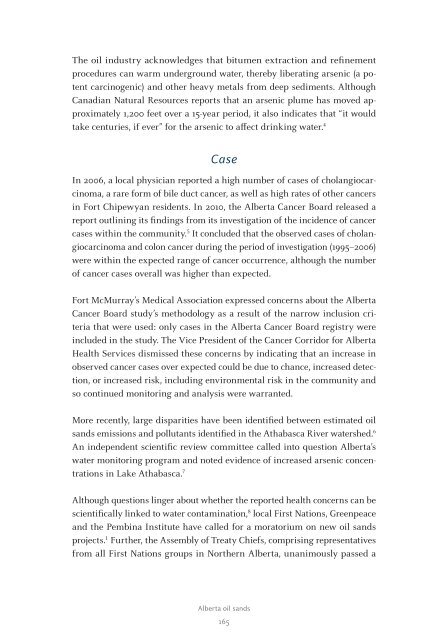PoPulationand Public HealtH etHics
PoPulationand Public HealtH etHics
PoPulationand Public HealtH etHics
Create successful ePaper yourself
Turn your PDF publications into a flip-book with our unique Google optimized e-Paper software.
The oil industry acknowledges that bitumen extraction and refinement<br />
procedures can warm underground water, thereby liberating arsenic (a potent<br />
carcinogenic) and other heavy metals from deep sediments. Although<br />
Canadian Natural Resources reports that an arsenic plume has moved approximately<br />
1,200 feet over a 15-year period, it also indicates that “it would<br />
take centuries, if ever” for the arsenic to affect drinking water. 4<br />
Case<br />
In 2006, a local physician reported a high number of cases of cholangiocarcinoma,<br />
a rare form of bile duct cancer, as well as high rates of other cancers<br />
in Fort Chipewyan residents. In 2010, the Alberta Cancer Board released a<br />
report outlining its findings from its investigation of the incidence of cancer<br />
cases within the community. 5 It concluded that the observed cases of cholangiocarcinoma<br />
and colon cancer during the period of investigation (1995–2006)<br />
were within the expected range of cancer occurrence, although the number<br />
of cancer cases overall was higher than expected.<br />
Fort McMurray’s Medical Association expressed concerns about the Alberta<br />
Cancer Board study’s methodology as a result of the narrow inclusion criteria<br />
that were used: only cases in the Alberta Cancer Board registry were<br />
included in the study. The Vice President of the Cancer Corridor for Alberta<br />
Health Services dismissed these concerns by indicating that an increase in<br />
observed cancer cases over expected could be due to chance, increased detection,<br />
or increased risk, including environmental risk in the community and<br />
so continued monitoring and analysis were warranted.<br />
More recently, large disparities have been identified between estimated oil<br />
sands emissions and pollutants identified in the Athabasca River watershed. 6<br />
An independent scientific review committee called into question Alberta’s<br />
water monitoring program and noted evidence of increased arsenic concentrations<br />
in Lake Athabasca. 7<br />
Although questions linger about whether the reported health concerns can be<br />
scientifically linked to water contamination, 8 local First Nations, Greenpeace<br />
and the Pembina Institute have called for a moratorium on new oil sands<br />
projects. 1 Further, the Assembly of Treaty Chiefs, comprising representatives<br />
from all First Nations groups in Northern Alberta, unanimously passed a<br />
Alberta oil sands<br />
165
















